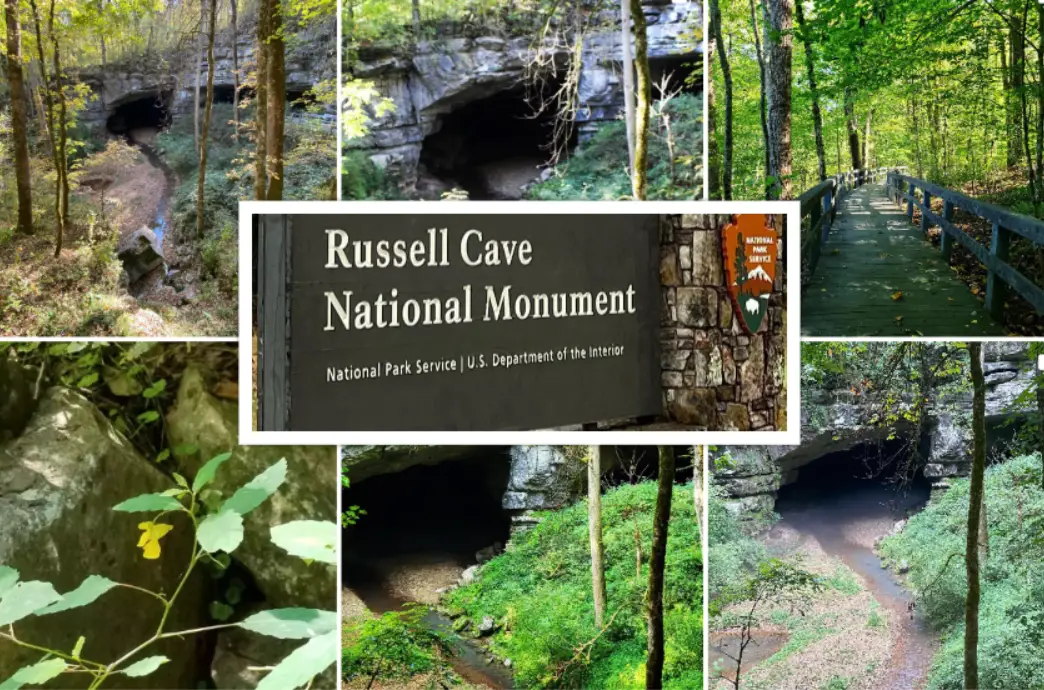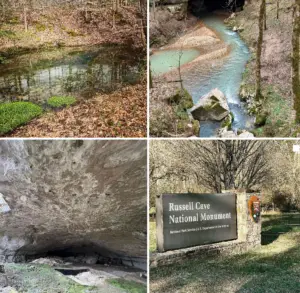Russell Cave National Monument : Interesting Facts, History & Travel Guide

- By
- Aparna Patel
- |
- 13 Apr, 2023
- |

Welcome to the world of Russell Cave National Monument, a fascinating destination nestled in the heart of Alabama. This magnificent national monument is a testament to the rich history and cultural heritage of the American South. With its stunning natural landscapes, unique geological formations, and a diverse array of flora and fauna, Russell Cave offers visitors an unforgettable experience. I
n this blog, we will delve deep into the interesting facts, history, and travel guide of Russell Cave National Monument. From its ancient Native American past to its present-day offerings, we’ll cover it all. So, fasten your seat belts and get ready for a journey through time as we explore one of the most remarkable national monuments in the United States.
Table of Contents
Interesting facts about Russell Cave National Monument
- Russell Cave National Monument is located in northeastern Alabama, and it is one of the oldest known archaeological sites in the United States.
- The cave system at the monument is over 7.5 miles long, and it has been used by humans for over 10,000 years.
- The cave system is named after Thomas Russell, a Scottish trader who is said to have used the cave as a shelter in the late 18th century.
- The cave system is rich in archaeological artifacts, including pottery, stone tools, and animal bones, which have helped researchers learn about the lifestyles and cultures of the people who lived in the area over thousands of years.
- The cave is also home to a variety of animal species, including bats, salamanders, and cave crickets.
- Russell Cave National Monument was established in 1961, and it is managed by the National Park Service.
- Visitors to the monument can explore the cave system on guided tours, as well as hike the trails that wind through the surrounding forest.
- The park is also home to a visitor center, which features exhibits about the history and culture of the area, as well as a bookstore and a picnic area.
Information & History of Russell Cave National Monument
Russell Cave National Monument is a protected area located in northeastern Alabama, USA, near the town of Bridgeport. It was established in 1961 by the National Park Service to preserve the archaeological and cultural significance of the area. The monument is named after Russell Cave, a large limestone cavern located on the property that has been used by humans for thousands of years.
The cave was first occupied by Native Americans around 10,000 years ago, and was used as a shelter and a source of food and water. The cave’s location near the Tennessee River and its abundant wildlife made it an attractive place for early human settlement. Over the centuries, the cave was occupied by various cultures, including the Paleo-Indians, Archaic, Woodland, and Mississippian peoples.
Archaeological excavations at Russell Cave have uncovered a wealth of artifacts, including pottery, stone tools, and animal bones, that have provided valuable insight into the lifestyles and cultures of the people who lived in the area over thousands of years. The site is one of the oldest known archaeological sites in the United States, and is considered to be of great importance to our understanding of North American prehistory.
The monument covers an area of approximately 310 acres, and includes not only the cave system, but also the surrounding forest and natural habitats. Visitors to the monument can explore the cave on guided tours, hike the trails that wind through the forest, and learn about the history and culture of the area at the visitor center. The park is also home to a campground, picnic areas, and other amenities for visitors.
In addition to its archaeological and natural significance, Russell Cave National Monument is also important for its cultural and historical value to the people of the southeastern United States, particularly the Cherokee and other indigenous peoples who lived in the region. The park is dedicated to preserving and sharing this rich heritage with visitors from around the world.
Read More:
- Rose Atoll Marine National Monument : Interesting Facts, History
- Rainbow Bridge National Monument : Interesting Facts, History & Travel Guide
- President Lincoln and Soldiers’ Home : Interesting Facts, History
Travel Guide for Russell Cave National Monument
Russell Cave National Monument is a beautiful and historic destination located in northeastern Alabama. Here is a travel guide to help you plan your visit:
- Getting there: The nearest airport is Huntsville International Airport, which is approximately 50 miles away. From there, you can rent a car or take a taxi to the monument. Alternatively, you can drive to the park, which is located just off of US Highway 72.
- Entrance fee: There is no entrance fee to Russell Cave National Monument, although donations are welcome.
- Hours: The park is open daily from 8:00am to 5:00pm, except for Thanksgiving Day, Christmas Day, and New Year’s Day.
- Guided tours: The cave system at Russell Cave National Monument can only be visited on a guided tour. Tours are offered daily, and reservations are recommended, especially during peak season. The tours last approximately 45 minutes and cover a distance of about 0.3 miles. Visitors are advised to wear comfortable walking shoes and to bring a light jacket, as the cave can be cool and damp.
- Visitor center: The park’s visitor center features exhibits about the history and culture of the area, as well as a bookstore and a picnic area. The center is open daily from 8:00am to 4:30pm.
- Hiking trails: The park offers several hiking trails that wind through the surrounding forest and offer scenic views of the area. The trails range from easy to moderate, and are suitable for all ages and fitness levels.
- Camping: The park has a campground with 26 sites that are available on a first-come, first-served basis. The campground is open year-round, and offers amenities such as picnic tables, grills, and a bathhouse.
- Nearby attractions: There are several other attractions in the area that are worth visiting, including the nearby town of Bridgeport, which offers restaurants, shops, and historic sites. Other nearby attractions include the Tennessee River, the Lookout Mountain Scenic Parkway, and the Natchez Trace Parkway.
Overall, Russell Cave National Monument is a fascinating and educational destination that offers something for everyone. Whether you are interested in archaeology, history, or outdoor recreation, this park is sure to be a highlight of your visit to northeastern Alabama.
More Post:
- Pipe Spring National Monument : Interesting Facts, History & Travel Guide
- Petroglyph National Monument : Interesting Facts, History & Travel Guide
- Organ Pipe Cactus National Monument : Interesting Facts, History & Travel Guide
- Prehistoric Trackways National Monument : Interesting Facts, History & Travel Guide
- Pompeys Pillar National Monument : Interesting Facts, History & Travel Guide
FAQ About Russell Cave National Monument
What can visitors do at Russell Cave National Monument?
Visitors to the monument can explore the cave on guided tours, hike the trails that wind through the forest, and learn about the history and culture of the area at the visitor center. The park is also home to a campground, picnic areas, and other amenities for visitors.
Are there fees to enter the park?
There is no entrance fee to Russell Cave National Monument, although donations are welcome.
When is the park open?
The park is open daily from 8:00am to 5:00pm, except for Thanksgiving Day, Christmas Day, and New Year’s Day.
How do I make reservations for a cave tour?
Tours of the cave can be reserved by calling the park or by visiting the park’s visitor center. Reservations are recommended, especially during peak season.
Is there camping available at the park?
Yes, the park has a campground with 26 sites that are available on a first-come, first-served basis. The campground is open year-round, and offers amenities such as picnic tables, grills, and a bathhouse.
Are pets allowed in the park?
Pets are allowed in the park, but they must be kept on a leash and are not allowed in the cave.
Search Posts
Latest posts
-
4 Mar, 2024
Why would you wrap your luggage in plastic?
-
5 Mar, 2024
Passing through airport security with autism
Popular posts
-
5 Mar, 2024
Why prohibit engine braking?